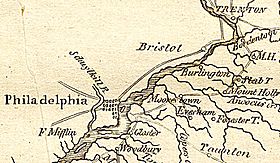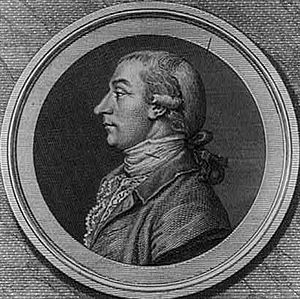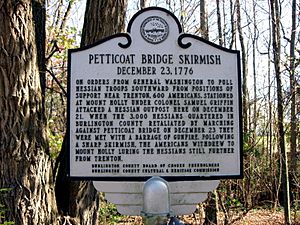Battle of Iron Works Hill facts for kids
Quick facts for kids Battle of Iron Works Hill |
|||||||
|---|---|---|---|---|---|---|---|
| Part of the American Revolutionary War | |||||||
 Map, c. 1806, showing towns most relevant to the Battle: Bordentown, Moorestown and Mount Holly, NJ. |
|||||||
|
|||||||
| Belligerents | |||||||
| Commanders and leaders | |||||||
| Strength | |||||||
| 500–600 militia | 2,000 British and Hessian troops | ||||||
| Casualties and losses | |||||||
| minor (see Aftermath) | minor (see Aftermath) | ||||||
The Battle of Iron Works Hill, also called the Battle of Mount Holly, was a series of small fights. They happened on December 22 and 23, 1776, during the American Revolutionary War. These battles took place in Mount Holly, New Jersey.
The American side was mostly made up of local soldiers called militia. They were led by Colonel Samuel Griffin. The other side had about 2,000 Hessian and British soldiers. They were led by Colonel Carl von Donop.
Even though the American force of 600 was pushed back, their actions were very important. They kept von Donop and his soldiers from being in Bordentown. This meant von Donop could not help another Hessian group in Trenton. That group was attacked and defeated by George Washington's army. Washington's troops had crossed the Delaware River on Christmas night, 1776.
Why the Battle Happened
In July 1776, British forces landed in Staten Island. They were led by General William Howe. For several months, Howe's soldiers chased George Washington's Continental Army. They pushed them out of New York City and across New Jersey. Washington's army was getting smaller. Many soldiers' enlistments were ending, and some left because they felt discouraged.
By November, Washington's army found safety in Pennsylvania. They were on the west side of the Delaware River. Washington made sure to remove all boats. This stopped the British from crossing the wide river.

General Howe set up many outposts across New Jersey. He ordered his troops to settle in for the winter. The furthest south outposts were in Trenton and Bordentown. About 1,500 Hessian soldiers were in Trenton. They were led by Johann Rall. In Bordentown, there were about 2,000 Hessian and British soldiers. They were led by Colonel Carl von Donop.
Bordentown was not big enough for all of von Donop's soldiers. He wanted to quarter some troops further south in Burlington. Many people there supported the British. But American gunboats on the river threatened the town. So, von Donop had to spread his troops out in the nearby countryside.
The soldiers in Trenton and Bordentown were often attacked by American rebels. These attacks were from local militia groups. These actions made the soldiers and their leaders very nervous. They never knew when or where an attack would happen. This made them jumpy and always on alert.
One American militia group formed in December 1776. It was led by Colonel Samuel Griffin from Virginia. Griffin's group likely included soldiers from Virginia, Pennsylvania, and New Jersey. They numbered between 500 and 600 men. By mid-December, they reached Moorestown. This was about ten miles southwest of Mount Holly.
By December 21, Griffin had moved to Mount Holly. He set up a simple fort on a hill. This hill was near an iron works, south of the Rancocas Creek. Von Donop sent a loyalist to check on them. The loyalist reported that Griffin's force was "not above eight hundred." He said nearly half were boys, and most were militia.
A British officer named Thomas Stirling heard rumors. He was seven miles north of Mount Holly. He heard there were 1,000 rebels at Mount Holly. He also heard 2,000 more were coming to support them. Von Donop asked Stirling for advice. Stirling told him to attack.
The Battle Begins
On December 21, about 600 of Griffin's soldiers attacked a British outpost. It was about one mile south of Blackhorse, at Petticoat Bridge. Griffin's men easily won this small fight.
On the evening of December 22, Joseph Reed visited Griffin in Mount Holly. Reed was an important officer for George Washington. Griffin had asked Reed for small cannons to help his group. Reed was planning an attack on the Hessians in Trenton with Washington. He wanted to see if Griffin's group could help by creating a distraction. Griffin was sick, and his men were not well-equipped. But they seemed to agree to some actions for the next day.
On the morning of December 23, von Donop brought about 3,000 soldiers. They were British and Hessian troops. They went to Petticoat Bridge. There, they easily defeated Griffin's men. Griffin's soldiers then retreated to Mount Holly. Von Donop reported seeing about 1,000 men near the town's meeting house.
A Hessian officer, Captain Johann Ewald, said about 100 men were on a hill near the church. They quickly left after a few cannon shots. Griffin's troops slowly moved back to their fortified position on the hill. Then, both sides fired at each other from a distance. The firing did not cause much damage.
What Happened Next
Von Donop's soldiers camped in Mount Holly on the night of December 23. According to Ewald, they took things from the town. Von Donop himself stayed in a house. The next day, December 24, they planned to push the militia off the hill. But Griffin and his men had already left for Moorestown during the night.
For some reason, von Donop and his soldiers stayed in Mount Holly. This town was 18 miles (29 km) and a full day's march from Trenton. They stayed there until December 26. That's when a messenger arrived. He brought news that Rall's Hessian group in Trenton had been defeated by Washington that morning.
News about the fights at Mount Holly was often exaggerated. Reports from that time varied. One Pennsylvanian claimed sixteen enemy soldiers were killed. A New Jersey militiaman reported seven enemy killed. Both von Donop and Ewald said no British or German soldiers were hurt in the first fight on December 22. The Pennsylvania Evening Post reported "several" enemy casualties. It said two militia members were killed and seven or eight wounded in the whole action.
Some people thought Griffin was sent to trick von Donop away from Bordentown. But von Donop decided to attack before Reed even arrived. Reed wrote in his journal that this "maneuver, though perfectly accidental, had a happy effect." It drew von Donop away. Washington's plan for crossing the Delaware River did include sending militia to help Griffin attack von Donop. However, this group of militia failed to cross the river.
Legacy
The hill where Griffin's militia fought is now part of Iron Works Park in Mount Holly. The battle is re-enacted there every year.



